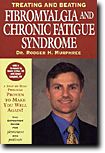|
|
Treating and Beating Fibromyalgia and Chronic Fatigue Syndrome
Book Review
by
Steven Lavitan, DC, LAc
| Title: |
Treating and Beating Fibromyalgia and Chronic Fatigue Syndrome |
| Author: |
Dr. Rodger Murphree
|
| Publisher: |
Cardinal Publisher's Group, 2004 |
| Type: |
Paperback, 281 pages |
| Price: |
$19.95 |
| Part #: |
T-255 |

The book runs into a little trouble right on the cover with the claim, "The definitive guide for physicians and patients." Since when does the typical patient know as much as the average physician? This trend in writing books for two different audiences is not a good one.
The author is indeed writing from a position of knowledge and experience. He includes sections on physical and spiritual approaches, but most of the book is from the chemical viewpoint. He discusses some of the most sophisticated pharmaceutical, vitamin, herbal, and amino acid you are likely to see anywhere. For the health care professional, this information causes a great hunger, and for the layman, probably a large headache.
The appendix contains symptom profiles for yeast problems, Wilson syndrome (the thyroid problem, not the copper disease), brain function, parasites, adrenal fatigue risk, as well as the ranges and significance of numerous blood, stool, saliva and hair analyses.
Now, for the million-dollar question: Does the material in this book indeed work for fibromyalgia or chronic fatigue syndrome? Recently, when a patient came in who met the criteria, they were referred to a colleague who handles these patients more regularly. Although this book gives an excellent overview and discusses these syndromes in terms of depletion of neurotransmitters, adrenal and thyroid imbalances, leaky gut syndrome, immune problems, and other factors, the depth of knowledge does not give one the confidence to treat.
However, the book is thought-out, well-written and makes the best case for a DC-MD practice that this reviewer has seen to date. There are situations in which pharmaceuticals can augment nutrients. There are times when having an MD or DO is worthwhile for prescribing pharmaceuticals, ordering certain tests, getting reimbursement, or just achieving more patient cooperation.
The clinical gems included in Treating and Beating Fibromyalgia and Chronic Fatigue Syndrome seem never-ending. For example, there is a challenge test using lactulose and mannitol. After the patient drinks a cocktail containing both, urine is collected for six hours. If the large lactulose molecules are not in the urine sample, it suggests intestinal permeability or leaky gut syndrome. If the small mannitol is in the urine, malabsorption is a distinct possibility. The brain function profiles are based on the patient filling out a form about his or her psychological tendencies. Depending on the items checked, one can determine if the patient is in the "O," "G," "D," "N" or "S" group(s) - opioid, GABA, dopamine, norepinephrine, or serotonin deficiencies, respectively.
Dr. Murphree is the doctor of the future Edison talked about. If fibromyalgia or chronic fatigue syndrome descended upon either me or my family, Dr. Murphree's center in Alabama would be my first choice to go for treatment. The book is recommended for chiropractors interested in treating these conditions, and rates a solid 9 because it has much information in a world that has little. However, if the author's goal was a complete sharing of information so his techniques can be duplicated, it was not achieved. Dr. Murphree should continue on what he has begun; great things can be expected of him, and hopefully his next text will be written for health care providers exclusively.
Dr.
Lavitan's
Rating:
 9 out
of 10 9 out
of 10
|

|








